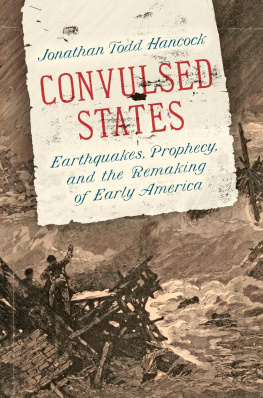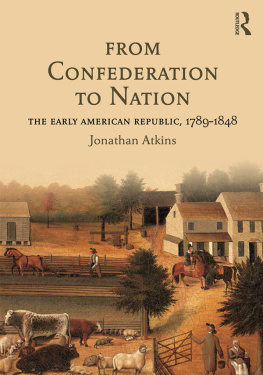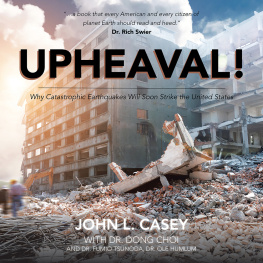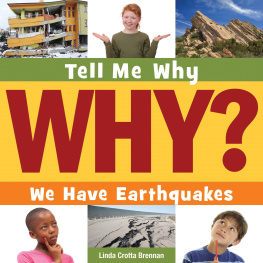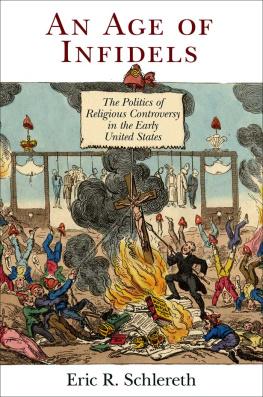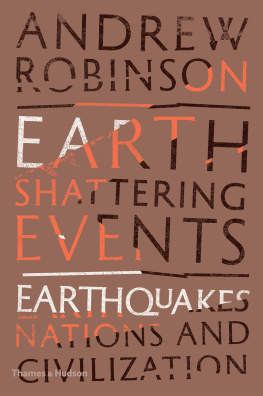2021 The University of North Carolina Press
All rights reserved
Designed by Jamison Cockerham
Set in Arno, Scala Sans, Amaltea, and Rudyard by Tseng Information Systems, Inc.
Cover illustrations: flood scenes from the front page of the Marceline Business Directory, Marceline, Mo. (Nell and Kyes, 1891); courtesy Library of Congress Prints and Photographs Division.
Manufactured in the United States of America
The University of North Carolina Press has been a member of the Green Press Initiative since 2003.
LIBRARY OF CONGRESS CATALOGING-IN-PUBLICATION DATA
Names: Hancock, Jonathan Todd, author.
Title: Convulsed states : earthquakes, prophecy, and the remaking of early America / Jonathan Todd Hancock.
Description: Chapel Hill : The University of North Carolina Press, 2021. | Includes bibliographical references and index.
Identifiers: LCCN 2020038670 | ISBN 9781469662176 (cloth) | ISBN 9781469662183 (paperback ; alk. paper) | ISBN 9781469662190 (ebook)
Subjects: LCSH: EarthquakesUnited StatesHistory19th century. | Indians of North AmericaGovernment relations17891869. | Nation-buildingUnited States. | United StatesHistory19th century. | United StatesReligion19th century.
Classification: LCC E179 .H225 2021 | DDC 323.1197dc23
LC record available at https://lccn.loc.gov/2020038670
a wave grant
Figure Foundation
tides of mind
Acknowledgments
Ive never experienced an earthquake. One shook Chapel Hill while I lived there, but it didnt register to me from the recesses of the library, where I was scanning microfilm for earthquake references. Over the course of this effort, what I have experienced is guidance, support, and love beyond measure.
Two people inspired me to take the plunge into becoming a history professor. Craig Steven Wilder showed me the transformative power of historical perspective and the critical importance of historiography and Early America. Craig D. Atwood introduced me to the practice of being a historian and the educational tradition of John Comenius. While this books subject matter ranges far from their work, I hope it reflects their influence. As a college student, I also was fortunate to learn from John P. Bowes, Colin G. Calloway, Clarence E. Hardy III, and Celia E. Naylor.
Kathleen DuVal let me run with my strange earthquake idea, offering guidance and encouragement along the way. Ill always be grateful for her mentorship and good cheer (and Marty Smiths cooking). While in the Research Triangle, I learned from an incredible cast of other faculty: the late Andrew R. L. Cayton, Elizabeth A. Fenn, the late Michael D. Green, Clara Sue Kidwell, Theda Perdue, Cynthia Radding, John Wood Sweet, and Harry L. Watson. A special thanks to Theda Perdue, whose advice about organizing the book was immensely helpful in moving it along. Conevery Bolton Valencius assured me that the earthquakes were big enough for the both of us to write about, and I have learned much from her work. I am also grateful to friends and colleagues from the profession and beyond: Thomas Vasilos, Anders Larson, Alex Punger, Jack Dunlap, David Williard, Anna Krome-Lukens, Aaron Hale-Dorrell, Kim Kutz, Nora Doyle, Liz Lundeen, Tol Foster, Warren Milteer, Rike Brhfener, Kathleen Conti, Liz Ellis, Brooke Bauer, Mikala Adams, Julie Reed, Marty Richardson, Jacob Lee, Paul Heintz, Adam Michaelson, Jason Hartwig, Stephen Macekura, Annie Depper, Catherine Conner, and Emily and Chris Kreutzer.
Numerous institutions made my research and writing possible. At the University of North Carolina at Chapel Hill, I am grateful to the Royster Society of Fellows, the Center for the Study of the American South, the Program in Medieval and Early Modern Studies, the Graduate School, and the History Department. I also appreciate the support of the Newberry Library, the Filson Historical Society, the Southern Baptist Historical Library and Archives, the Kentucky Historical Society, the Huntington Library, the Bright Institute at Knox College, and Hendrix College. Spending time at the Newberry Library with Juliana Barr, the late Raymond D. Fogelson, and Scott Manning Stevens was especially formative. Joining the inaugural cohort of the Bright Institute at Knox College, directed by Catherine J. Denial, has been a rousing bookend to this book writing experience. I also thank the staffs of all of the libraries and archives cited in the book, as well as those librarians who facilitate interlibrary loan. On the road, Anders and Jess Larson and Hunter Price kindly hosted me at their homes during research trips through the Midwest, and Bo Taylor welcomed me into the 2009 Cherokee Language Immersion Course at the Museum of the Cherokee Indian on the Qualla Boundary.
I appreciated the opportunities to present portions of this work and receive feedback at workshops held by the Triangle Early American History Seminar, the Carolina Seminar in American Indian and Indigenous Studies, and the Newberry Library Seminar Series in American Indian and Indigenous Studies, as well as meetings of the American Society for Ethnohistory, the Native American and Indigenous Studies Association, the Organization of American Historians, the Society of Early Americanists, and the Southern Historical Association.
I am grateful to Hendrix College for the institutional support and flexibility to pursue my research and teaching interests. I thank my departmental colleagues, Todd Berryman, Sasha Pfau, Allison Shutt, Deb Skok, and Mike Sprunger, for their welcome and guidance. Ive also appreciated the chance to collaborate with Hendrix faculty and staff members beyond the History Department: Jay Barth, Hope Coulter, Pete Gess, Robin Hartwick, Brett Hill, Mary Kennedy, Peter Kett, Kiril Kolev, Stacey Schwartzkopf, David Sutherland, and Leslie Templeton. Thanks also to Jasmine Zandi, Hendrix class of 2020, for creating the maps, and to Brett Hill for guiding Ms. Zandi.
It has been an honor to work with the University of North Carolina Press; I appreciate the work of Chuck Grench, Brandon Proia, Dylan White, Jay Mazzocchi, Elizabeth Crowder, and the rest of the staff. Readers Cynthia Kierner and Christina Snyder lent their expertise and keen insight to strengthen the manuscript. The book is better for their feedback, though errors of fact or interpretation belong to me.
In 2017, Devin and I found out just how fortunate we are to live in downtown Little Rock. We express our heartfelt gratitude to Anita Davis, Caroline Stevenson, and Kelly Fleming, and to the doctors, nurses, and staff at the Winthrop P. Rockefeller Cancer Institute at the University of Arkansas for Medical Sciences, especially Drs. Daniela A. Ochoa, Angela Pennisi, Allen C. Sherman, and Keith G. Wolter.

